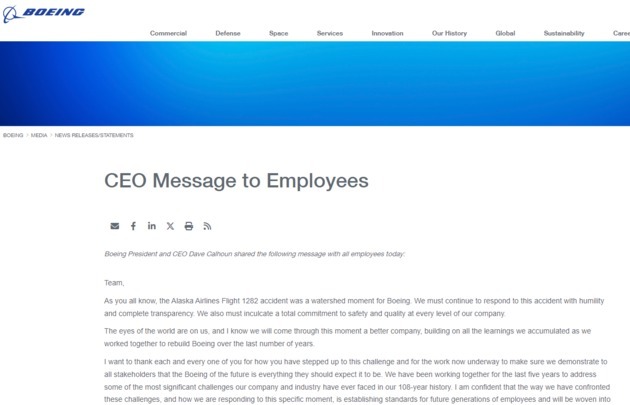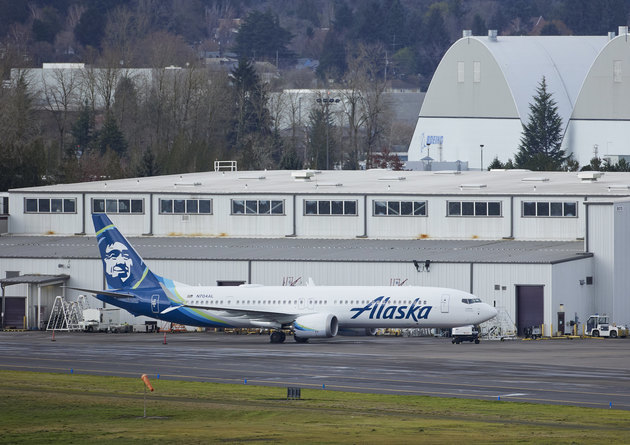Amid ongoing safety crises with the Boeing 737 MAX series, Boeing has experienced a dramatic management reshaffle.
On Monday, March 25th, Eastern Time, Boeing announced that as part of a management restructuring plan, its CEO, Chairman, and head of the commercial airplanes division will all be stepping down.
In a statement, Boeing said that CEO Dave Calhoun will resign at the end of 2024. Chairman Larry Kellner will leave the board at the company’s annual meeting in May, with former Qualcomm CEO Steve Mollenkopf set to take over the position. Additionally, Stan Deal, president of Boeing Commercial Airplanes, will leave the company effective immediately, with COO Stephanie Pope succeeding him.
In the midst of this sudden “earthquake” of personnel changes, Boeing’s stock price defied trends by nearly rising 4%, ultimately closing up 1.36% on Monday.
An anonymous civil aviation expert, in an interview with NBD, expressed skepticism about whether these changes could fundamentally reverse Boeing’s predicament. He believes that Boeing’s current problems lie not with its leadership but with the technical capabilities of its execution layer. Boeing is essentially starting over, rebuilding its manufacturing capabilities.
Frequent safety issues occurred
Due to a series of safety crises involving the 737 MAX model, which triggered comprehensive regulatory investigations and public panic, Boeing was compelled to make a significant reshuffle in personnel. Dave Calhoun, the CEO who took the helm during Boeing’s darkest times, has chosen to step down proactively.
In a letter to employees, Calhoun called the Alaska Airlines incident "a watershed moment for Boeing" and thanked employees for how they "stepped up" to the challenge of making sure the future of Boeing is everything stakeholders expect it to be.”

Photo/Boeing
Since 2024, Boeing airplanes have repeatedly experienced safety incidents. On the afternoon of January 5, 2024, a Boeing 737 MAX 9 aircraft operated by Alaska Airlines lost a cabin door shortly after takeoff, forcing an emergency landing. In February, a Boeing 757 plane from United Airlines flying from San Francisco to Boston had to make an emergency landing after discovering a “crack” in one wing during the flight.
On March 4th, the Federal Aviation Administration (FAA) website published the investigation progress of the Boeing “door loss” incident. The report stated that Boeing and its fuselage parts supplier, Spirit AeroSystems, had non-compliant issues with parts handling, storage, and quality control during the manufacturing process of the 737 MAX aircraft.
To hold Boeing accountable for the quality of its products, the FAA stated in the report that it has ordered Boeing to halt the expansion of 737 MAX aircraft production and to have an independent review of its quality system by a third party, emphasizing a thorough review of all of Boeing’s corrective measures.
Insider: root cause lies not with its leadership
NBD noticed that before Christmas 2019, Boeing suddenly announced the dismissal of then-CEO Dennis Muilenburg and appointed Calhoun as his successor. In January 2020, Calhoun officially took office, with the goal of resolving the crisis at the aircraft manufacturer. It should be pointed out that Muilenburg was forced to resign as CEO at the request of the company, and the new successor was announced immediately after the announcement of his dismissal. However, Calhoun told CNBC on Monday that he resigned "100%" voluntarily and left a long transition period of 9 months.
When Calhoun took office, Boeing was nearly in a state of chaos. Two crashes of the popular new single-aisle 737 MAX8 occurred within a few months, and many problems exposed in subsequent investigations led to serious consequences in terms of production, including the global grounding and suspension of production of the model.
What's more serious is that the good reputation that this "century-old store" has accumulated in the aircraft manufacturing industry through its many star products has become fragile in a short period of time. Therefore, in addition to quickly eliminating the chaos, the most important task before Calhoun is to help this former "golden signboard" of American manufacturing rebuild trust.
However, the Alaska Airlines Flight 1282 accident left Calhoun's four-year "firefighting" career with an embarrassing ending.
CNN reported that Boeing used to attach great importance to the excellent engineering and technical capabilities of its senior executives, and its aircraft were the gold standard in the industry. Critics say that Boeing's focus has changed over the past 25 years. The company's downfall can be traced back to a significant merger with McDonnell Douglas in 1997, leading to a shift in priorities from quality and safety to cost-cutting and shareholder value.
Calhoun's background is also a microcosm of this change. He has no engineering background, but has extensive management and operational experience. He has served as a senior managing director and portfolio operations officer at Blackstone Group and worked at General Electric (GE) for 26 years.
Regarding whether Calhoun's resignation can reshape Boeing's image and restore market confidence, an unnamed civil aviation expert told NBD that Boeing's current problem is not a leadership problem, but a technical capability problem at the executive level. The current Boeing is equivalent to starting over and rebuilding its own manufacturing capabilities.

Photo/Xinhua, AP
Airlines’ Dissatisfaction Grows Over Boeing 737 MAX Delivery
The Wall Street Journal reports that as David Calhoun announced his departure, Boeing faced widespread criticism from customers. In fact, since the global grounding of the 737 MAX in 2019 and 2020, major airlines and leasing companies have been at odds with Boeing.
According to CNN, last week, CEOs of several airlines requested direct dialogue with Boeing’s board. On Monday, Calhoun attempted to describe such requests as normal procedure, but it is rare for customers to speak directly with the board in the industry.
These airlines are dissatisfied with the quality of the aircraft delivered by Boeing. Michael O’Leary, CEO of Ryanair, Europe’s largest airline operating only Boeing 737, said last week that whenever they receive a Boeing plane, “we spend 48 hours checking these planes for defects or other issues.”
Moreover, as passenger demand continues to soar to record levels, these airlines are also angry that Boeing cannot meet its delivery numbers this year.
United Airlines has also publicly expressed disappointment with the quality and delayed delivery times of Boeing’s aircraft. The airline is a major customer of the Boeing 737 MAX 10, but Boeing’s inability to get this aircraft certified for passengers is also problematic. United Airlines CEO Scott Kirby even described the Alaska Airlines incident as “the last straw that broke the camel’s back.” It is reported that United Airlines plans to receive MAX 10 aircraft this year but is currently considering purchasing alternatives from Airbus.
Regarding Boeing’s current predicament, an anonymous civil aviation industry expert told NBD that Boeing’s main challenge is the “lack of proficiency” due to a generational gap.
The anonymous source said, “Throughout 2019, the 737 MAX incident and the overall impact of the COVID-19 pandemic on the demand for civil aviation aircraft in 2020 caused Boeing’s 737 MAX production line to nearly come to a halt, severely affecting the entire supply chain, including suppliers. This led to a series of problems: some suppliers may face cash flow shortages and go bankrupt, necessitating the search for new suppliers; and the surviving suppliers’ production volumes will also decrease. This reduces the demand for industrial workers, causing many to lose their jobs, and experienced older workers and engineers to retire early.”
“By 2022 and 2023, when the market recovered, manufacturers found that the workers, engineers, and suppliers in the market lacked sufficient proficiency. In this situation, manufacturers had to proceed with production, which could likely lead to accidents, such as the recent Alaska Airlines 737 aircraft incident. The entire batch of aircraft delivered last October was inevitably affected by supply chain issues.”
As Boeing faces frequent accidents, some airlines hope to switch to Airbus, but this is not easy. Airbus has already committed to delivering a large number of backlogged aircraft orders to its existing customers, meaning any airline switching to Airbus may have to wait until 2030 or later to receive their planes.
Additionally, operating both Boeing and Airbus aircraft of the same class is costly because pilots are certified to fly only specific aircraft, and most cannot switch between Airbus and Boeing without training. Moreover, airlines need to provide expensive spare parts for each type of aircraft they operate.
Ben Minicucci, CEO of Alaska Airlines, recently estimated that after merging with Virgin America, the cost of operating Airbus and Boeing single-aisle jets for Alaska Airlines is between $75 million and $100 million annually, which is why Alaska Airlines decided to phase out Airbus jets after the merger.
As the fifth-largest airline in the United States, it is clear that larger airlines face higher costs when switching aircraft models.
Cover image: Xinhua/AP


 川公网安备 51019002001991号
川公网安备 51019002001991号





